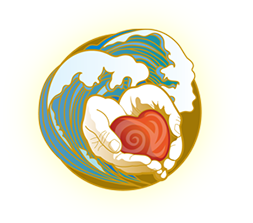
Ambivalence is created in the vacuum of trying to make right what is wrong. It is often generated by real events in our past where our needs were not met but we had to cope anyway. We did not have or did not perceive any other option. We were too young to know what we needed, to say no, or to leave. We had committed ourselves already. We found ourselves in situations where we didn’t feel safe but had no way out. If right and wrong represent either ends of a spectrum, then ambivalence is a grey area in between, a swamp of our own making, a place of safety when we don’t really know what safety is.
Right and wrong represent definite edges and clear boundaries, as do yes and no. It is important to know where our edges are and to have clear access to our yes and no. When someone does not hear or honor our yes or no, our relationship with them is challenged. When we cannot hear or honor our own yes or no, our relationship with ourselves is challenged.

Where our relationship with ourselves is challenged, we find ambivalence. Ambivalence is created by several factors including fear, lack of trust, and lack of confidence. Ambivalence can express in many ways including uncertainty about someone or something or about whether to take the next step. Being ambivalent keeps us out of contact with ourselves and others in essential ways. When ambivalent we exist in a familiar but unwelcome place where we cannot access or act out our own impulses. Without this access, we rely on the impulses and motivations of others for direction. When this becomes a habit or lifestyle, we can live a life of limitations and keep ourselves from reaching our goals, ending bad situations, or taking risks. When we are relying on others to make choices for us, we cannot live an engaged and meaningful life.
When we live ambivalently, we can spend an inordinate amount of time and energy trying to feel certain or make something perfect. Our need to be perfect sits atop a history that is rife with imperfections. Our need for certainty is real and valid; our lack of certainty keeps us ambivalent.
Paradoxically, if you are living an ambivalent life, it feels safer not to choose. Choices have consequences, and consequences are imagined as negative. If you want to stop living a life of ambivalence, you only have to make one choice: to stop. You can start stepping towards your convictions by not committing to anything or anyone without a clear yes to do so. There are many ways to find your yes and your no. Once you do, your ambivalence will become a tool, a guiding sensation that names your hesitation and helps you pivot to certainty.
If you choose to stop living ambivalently, your life will change. I know this to be true from my own experience. Once I chose to follow a different path, to go towards certainty rather than confusion, to pause when I met my confusion and wait for certainty to arise, I found love, happiness, capacity, and meaning beyond anything I could have imagined. Now it is part of my life work to help others with their ambivalence. I seek to facilitate profound and lasting transformation for people through deep and authentic connection to themselves and their own knowing.
Would you like to keep up to date with the happenings of the School of Inner Health and receive updates on upcoming courses, workshops, and trainings? Sign up for our newsletter here!
Also published on Medium.

